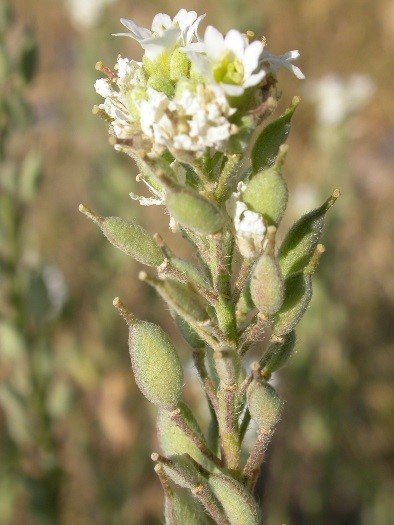Are invasive plant managers reducing viable seed production of hoary alyssum with herbicides?
(Uriel Menalled, Stacy Davis, and Jane Mangold)

Introduction
Hoary alyssum (Berteroa incana) is a weedy mustard that is listed as a priority 2B noxious weed in Montana. It can be found in disturbed areas, pastures, and rangelands. Managing hoary alyssum is difficult because it has an extended flowering period, during which plants simultaneously flower and produce seeds. Chemical control recommendations suggest that herbicides applied before flowering may be most effective; however, many invasive plant managers do not treat the weed until it has flowered. Unfortunately, when plants are flowering and easier to identify, they may also be producing seeds. We wanted to understand the effect of herbicides on hoary alyssum seed production to improve control of this weed.
Methods
Invasive plant managers sprayed hoary alyssum between June and July 2016 at six sites in southwestern Montana that were rights-of-way, natural areas, or rangelands. Managers used herbicides that were part of their regular management practices; some managers tested multiple treatments (table below). Half of the sites were spot-sprayed while the other half were broadcast sprayed. Managers left an area untreated for comparison. We collected hoary alyssum plants at each site ~4 weeks after treatment and returned to the lab where we estimated seed production and viability.
|
Site |
Nearest Town |
Type of application |
Treatments (Trade name and rate) |
|
Edwards Peninsula |
West Yellowstone |
Spot |
Escort + Milestone (1 oz/A, 6 oz/A) |
|
Stoddard Point |
West Yellowstone |
Spot |
Escort + Milestone (1 oz/A, 6 oz/A) |
|
Crane Lane |
West Yellowstone |
Spot |
Escort + Tordon + 2,4-D (1/5 tsp/gal, 1.5 oz/gal, 2 oz/gal) |
|
Airport |
Belgrade |
Broadcast |
Opensight + 2,4-D (3 oz/A, 1 qt/A) Perspective + 2,4-D (4oz/A, 1 qt/A) |
|
Tower |
Belgrade |
Broadcast |
Opensight + 2,4-D (3 oz/A, 1 qt/A) Perspective + 2,4-D (4oz/A, 1 qt/A) |
|
Brown Ranch |
Sheridan |
Broadcast |
E-2 + Escort (1.5 qt/A, 1 oz/A) Escort + 2,4-D (1 oz/A, 1 qt/A) Plateau (10 oz/A) Telar + 2,4-D (1 oz/A, 1 qt/A) |
Results
Hoary alyssum that wasn’t sprayed produced an average of 429 seeds/plant, but production ranged from 5-1860 seeds/plant. Most treatments reduced seed production by more than 60%. Seed production decreased 93-99% at sites where herbicides were spot sprayed (Edwards Peninsula, Stoddard Point, Crane Lane). Seed production decreased 64-98% at Airport and Tower where herbicides were broadcast sprayed. At Brown Ranch, Telar + 2,4-D resulted in an increase in seeds or had no effect (other 3 treatments). Hoary alyssum seed viability decreased by 49-100% compared to non-sprayed seeds with all treatments except Telar + 2,4-D at Brown Ranch where viability increased. This study showed that reducing viable seed production is possible with several different herbicides, even if applications occurred when hoary alyssum was flowering and seed pods were present.
